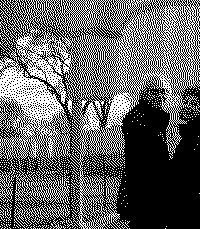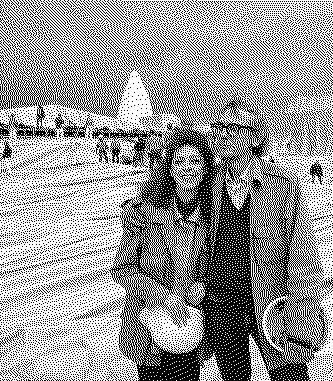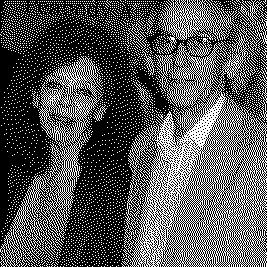Artists/Christo & Jeanne Claude
Fast Facts
Environmental Art Pioneers
Christo and Jeanne-Claude were pioneers in the field of environmental art, known for their large-scale, temporary installations that transformed landscapes and urban spaces. Their projects often involved wrapping buildings, bridges, and natural features in fabric (The Art Story) (Artland Magazine).
Self-Financed Projects
Unlike many artists, Christo and Jeanne-Claude funded their projects entirely through the sale of preparatory sketches, drawings, and models. This self-financing model allowed them to maintain complete artistic control and independence (Wikipedia) (Artnet News).
Famous Projects
Some of their most famous works include "Wrapped Reichstag" in Berlin (1995), "The Gates" in New York City’s Central Park (2005), and "The Floating Piers" on Italy’s Lake Iseo (2016). Each project required years of planning and extensive collaboration with engineers, construction workers, and local authorities (Wikipedia) (The Art Story) (Artland Magazine).
Temporary Installations
The ephemeral nature of their work was a central theme, with installations designed to exist for only a short period. This impermanence highlighted the transient beauty of their art and the fleeting nature of human experiences (The Art Story) (Artland Magazine).
Political and Social Commentary
Their works often carried significant political and social messages. For instance, "Wrapped Reichstag" symbolized Germany’s reunification and the transparency of democracy, while "The Wall of Oil Barrels - Iron Curtain" (1962) was a commentary on the Berlin Wall and Cold War tensions (The Art Story) (Artland Magazine).
Public Engagement
Their installations were designed to be accessible to the public, encouraging community interaction and participation. Projects like "The Gates" and "The Umbrellas" drew millions of visitors, creating shared experiences that bridged cultural and geographic divides (Wikipedia) (Artland Magazine).
Innovative Use of Fabric
They were renowned for their innovative use of fabric, which was meticulously chosen and manipulated to create dramatic visual effects. The fabric often interacted dynamically with the environment, responding to wind, light, and weather conditions (Wikipedia) (The Art Story) (Artland Magazine).
Biography



Christo Vladimirov Javacheff was born on June 13, 1935, in Gabrovo, Bulgaria. He studied at the Fine Arts Academy in Sofia before fleeing the communist regime in 1957 and eventually settling in Paris. In Paris, Christo initially made a living by painting portraits. Jeanne-Claude Denat de Guillebon was also born on June 13, 1935, in Casablanca, Morocco, to a French military family. The two met in 1958 when Christo was commissioned to paint a portrait of Jeanne-Claude's mother. Their meeting marked the beginning of a lifelong personal and professional partnership (The Art Story) (Artnet News).
Early Collaborative Work
In the late 1950s and early 1960s, Christo and Jeanne-Claude began their collaboration by wrapping everyday objects in fabric, transforming them into art pieces. These early works included wrapped bottles, cans, and furniture, reflecting their interest in altering the perception of mundane items. Their first significant public installation was "Iron Curtain - Wall of Oil Barrels" (1962), where they blocked a street in Paris with oil barrels as a protest against the Berlin Wall. This work showcased their willingness to engage with political themes and public spaces (The Art Story) (Artland Magazine).
Major Projects in the 1960s and 1970s
The 1960s and 1970s were transformative decades for the couple, as they began to execute large-scale environmental projects. In 1969, they created "Wrapped Coast" in Australia, wrapping a 2.5-kilometer section of coastline in fabric. This was followed by "Valley Curtain" (1972), where they suspended a massive orange curtain across a Colorado valley. Their projects during this period were characterized by their immense scale and temporary nature, requiring extensive planning, negotiation, and collaboration with various professionals (Wikipedia) (Artnet News).
The 1980s: Iconic Projects and Public Engagement
The 1980s saw Christo and Jeanne-Claude undertake some of their most ambitious projects. "Surrounded Islands" (1983) involved encircling 11 islands in Miami's Biscayne Bay with pink fabric, while "The Pont Neuf Wrapped" (1985) wrapped Paris’s oldest bridge in fabric. These projects attracted millions of visitors and generated significant media attention, emphasizing their ability to engage the public and transform urban spaces (Wikipedia) (Artland Magazine).
1990s: Continued Innovation and Success
The 1990s were marked by the realization of one of their most significant projects, "Wrapped Reichstag" (1995), which wrapped the German parliament building in Berlin. This project symbolized Germany's reunification and was viewed by millions. It took over two decades of negotiation to bring this project to fruition, demonstrating their persistence and dedication. Another notable project was "The Umbrellas" (1991), which installed blue and yellow umbrellas in Japan and California, respectively, highlighting cultural and environmental contrasts (Wikipedia) (The Art Story) (Artnet News).
The 2000s: "The Gates" and Jeanne-Claude’s Passing
In the 2000s, Christo and Jeanne-Claude completed "The Gates" (2005) in New York City's Central Park, where 7,503 gates with saffron-colored fabric lined 23 miles of pathways. This project drew millions of visitors and was a major success. Tragically, Jeanne-Claude passed away in 2009 from complications related to a brain aneurysm. Despite her passing, Christo continued their shared vision, planning and executing projects they had envisioned together (The Art Story) (Artland Magazine).
The 2010s: Continuing the Legacy
After Jeanne-Claude's death, Christo continued to realize their joint projects. In 2016, he completed "The Floating Piers" on Italy’s Lake Iseo, allowing visitors to walk on water. This installation was a testament to their enduring influence and Christo's dedication to their collaborative vision. Another posthumous realization was "The London Mastaba" (2018), a floating installation on the Serpentine Lake in Hyde Park, London. Christo also laid the groundwork for "L’Arc de Triomphe, Wrapped," which was completed in 2021, after his death in 2020 (Wikipedia) (Artnet News).
Legacy and Impact
Christo and Jeanne-Claude's work has left a profound impact on the field of environmental art. Their projects challenged traditional notions of art, emphasizing the temporary and transformative power of large-scale installations. Their self-financing model and dedication to artistic freedom allowed them to create works that were both monumental in scale and deeply personal in vision. Their legacy continues to inspire artists and captivate audiences worldwide (The Art Story) (Artland Magazine) (Artnet News).
Bodies of Work
-

Wrapped Coast
1968–1969
-

Valley Curtain
1970–1972
-

Running Fence
1972–1976
-

Wrapped Walk Ways
1977–1978
-

Surrounded Islands
1980–1983
-

The Pont Neuf Wrapped
1975–1985
-

The Umbrellas
1984–1991
-

Wrapped Reichstag
1971–1995
-

The Gates
1979–2005
-

The Floating Piers
-

The London Mastaba
2016–2018
-

L’Arc de Triomphe, Wrapped
1961–2021
Importance
Christo and Jeanne-Claude, through their large-scale environmental installations, significantly transformed the landscape of contemporary art.
Innovation in Art
Christo and Jeanne-Claude pioneered the concept of wrapping large structures and natural features in fabric, creating temporary art installations that redefined the viewer’s perception of familiar landscapes. Their projects, such as "The Gates" in Central Park and the "Wrapped Reichstag" in Berlin, showcased their ability to merge art with the environment, making profound statements about beauty, temporality, and the interaction between humanity and nature (The Art Story) (Art Movements - A Brief History).
Environmental Awareness
Many of their works, like "Surrounded Islands" in Biscayne Bay, highlighted the delicate balance between human activity and natural ecosystems. By integrating their art into diverse environments, they drew attention to the beauty and fragility of nature, encouraging viewers to appreciate and protect their surroundings (The Art Story) (Art Movements - A Brief History).
Public Engagement
Their installations were designed to be accessible to the public, often situated in urban parks or involving entire landscapes. This approach democratized art, bringing it out of galleries and museums and into public spaces, where it could be experienced by a broad audience. The temporary nature of their works also added a sense of urgency and uniqueness to the viewing experience (The Art Story) (Artland Magazine).
Logistical and Financial Ingenuity
Christo and Jeanne-Claude were known for their meticulous planning and innovative financing methods. They self-funded their projects through the sale of preparatory drawings and artworks, which allowed them to maintain complete artistic freedom and independence. This model set a precedent for future large-scale art projects, demonstrating how artists could achieve ambitious goals without relying on traditional funding sources (Art in Context) (Art Movements - A Brief History).
Political and Social Commentary
Their work often engaged with political and historical themes. The "Wrapped Reichstag," for example, symbolized Germany’s reunification and the country’s historical struggles. By wrapping significant buildings and landmarks, they provoked thought and dialogue about the past, present, and future of these spaces (The Art Story) (Artland Magazine).
Legacy and Influence
Christo and Jeanne-Claude's projects have left a lasting impact on the art world, inspiring future generations of artists to explore the intersections of art, nature, and urban environments. Their unique approach and the large scale of their installations continue to influence contemporary public art and environmental art movements (Art in Context) (Art Movements - A Brief History).
Technique
Christo and Jeanne-Claude were renowned for their innovative and distinctive artistic techniques, which set them apart in the world of contemporary art.
Wrapping
Their signature technique involved wrapping buildings, bridges, and natural landscapes in fabric. This process started with everyday objects and evolved to monumental projects such as "Wrapped Reichstag" in Berlin and "The Gates" in Central Park. The fabric they used was often specially designed to interact with light, enhancing the visual impact and transforming the perception of the wrapped objects (The Art Story) (Artnet News).
Site-Specific Installations
Their projects were meticulously designed to integrate with their specific environments, whether urban or natural. For example, "Running Fence" in California was a 24.5-mile-long white nylon fence that highlighted the landscape's contours, and "Surrounded Islands" in Miami encircled islands with pink fabric, drawing attention to the natural beauty and human interaction with the environment (Art in Context) (Artnet News).
Use of Fabric and Color
The choice of fabric and color was integral to their work. They selected materials that could reflect, transmit, or obscure light, creating dynamic visual effects. The saffron-colored fabric in "The Gates" and the shimmering silver of the "Wrapped Reichstag" are prime examples of how color played a crucial role in their installations (Art in Context) (New Atlas).
Engineering and Technical Precision
Each project required extensive technical planning and engineering. They often worked with architects, engineers, and environmental experts to ensure the feasibility and safety of their installations. For instance, "Valley Curtain" in Colorado involved significant engineering efforts to hang a large orange curtain between mountain slopes, while "The Umbrellas" project required careful consideration of wind conditions and structural stability (The Art Story) (Artnet News).
Environmental and Bureaucratic Navigation
Christo and Jeanne-Claude's projects often faced significant bureaucratic and environmental challenges. They navigated legal and political landscapes, securing permissions through persistent negotiation and legal battles. Their ability to manage these challenges was as much a part of their artistic process as the physical creation of their works (Artnet News) (New Atlas).
Temporary Nature and Ephemerality
A defining characteristic of their art was its temporary nature. Their installations were designed to exist for a limited time, emphasizing the transient beauty and impermanence of art. This aspect also underscored the extensive documentation and the creation of preparatory drawings and models, which became valuable artworks in their own right (The Art Story) (Art in Context).
Self-Funding Model
Christo and Jeanne-Claude financed their large-scale projects independently through the sale of preparatory sketches, models, and other artworks. This model ensured their artistic freedom and allowed them to undertake ambitious projects without external financial constraints (Art in Context) (New Atlas).

